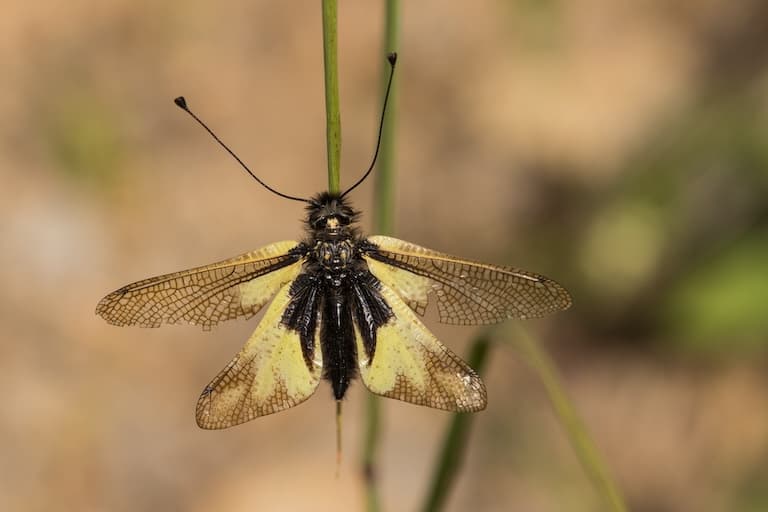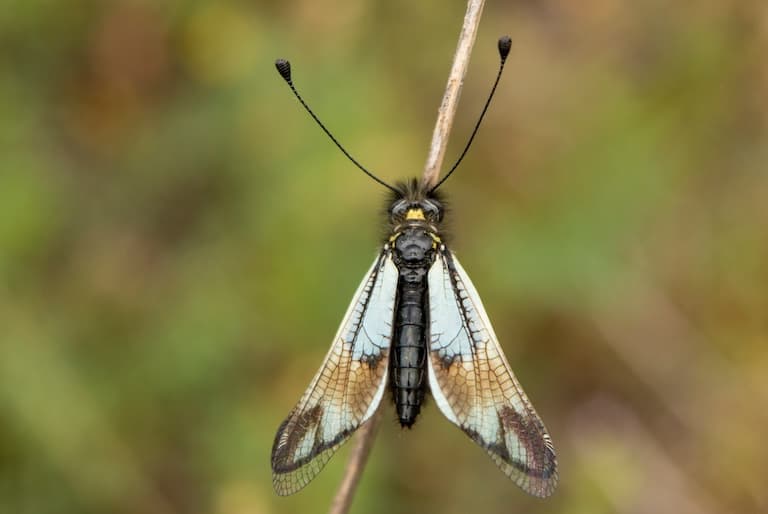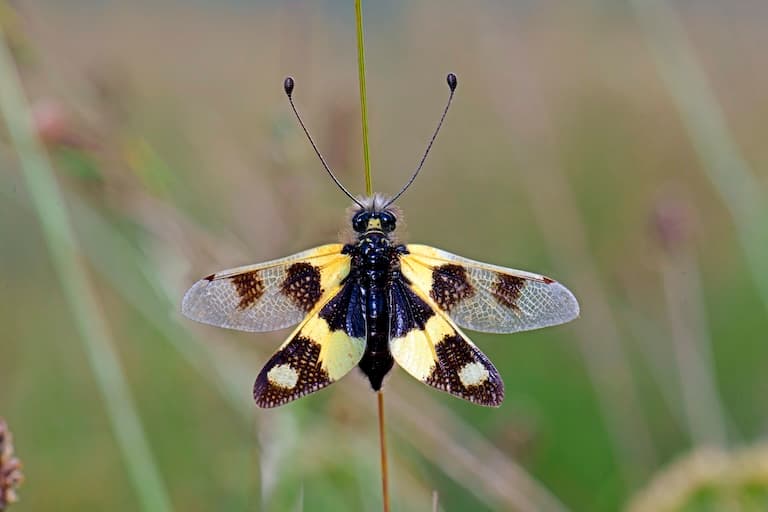Owlfly Profile
Before the dinosaurs, insects ruled. Well, directly before the dinosaurs, there were other reptiles in charge. And before them, amphibians ruled. But before ALL OF THAT, insects ruled the Earth.
And for hundreds of millions of years before the dinosaurs, they had plenty of time to get good. Taking to the sky 100 million years before vertebrates figured it out and 200 million years before birds, they’ve had a lot of practice, and many from the Permian are still doing it today.
Owlflies represent a prehistoric lineage of aerial predators that still dominate the skies after all this time.

Owlfly Facts Overview
| Habitat: | Mostly grasses and shrubland, also forests, or anywhere with leaf litter |
| Location: | Warm, temperate and tropical zones worldwide |
| Lifespan: | Unknown |
| Size: | Up to around 4 cm (1.5 in) long before antennae |
| Weight: | <1 g |
| Colour: | Varied, from plain, solid colouration to bright and patterned |
| Diet: | Other insects |
| Predators: | Birds, bats, frogs |
| Top Speed: | Fast |
| No. of Species: | 450 |
| Conservation Status: | Not Listed |
Owlflies are prehistoric hunters and have carried with them tools sharpened over hundreds of millions of years. They are second in both power and agility only to the dragonflies, but what they lack in strength they make up for in stealth. And they can fart a terrible musk, too.
These pretty little critters are more ferocious than they look, and their babies come straight out of the depths of hell.
Interesting Owlfly Facts
1. They’re Neuropterans
Neuropterans are some of the oldest aerial predators on Earth, and once ruled the sky alongside the giant Odonatans like Meganeuropsis through the Permian period, long before any other animals had considered evolving flight.
Today, over 6,000 species are recorded, including commonly known insects like the lacewings and ant lions.
And it is ant lions that are most closely related to Owlflies, being as they both are, terrifying hunters in the insect world.
Like dragonflies, they have four wings, large eyes, and can hover or change direction fast, but they are not very closely related and have simply evolved similar traits convergently, to occupy similar niches.
Owlflies have massive mandibles, soft bodies, and long, clubbed antennae, which set them apart from similar-looking insects. They also sit on sticks differently than dragonflies, with their abdomens sticking out perpendicular to the surface they’re hanging on.

2. They’re ancient
Fossils of owlflies are found in ancient Baltic amber, and most of these originate from the Oligocene, around 23 million years ago. But the owlfly line goes back much further than this, with their ancestral species predating the Jurassic period.
Modern owlflies show up in the late Jurassic, and this order of insects represents some of the earliest animals to undergo complete metamorphosis.
3. They’re owl-like
Aside from the metamorphosis, these insects do have some things in common with their namesakes. Many are crepuscular, setting off from their branches to find and slaughter hapless victims with their mouths.
They are stealthy animals, and then fast and powerful killers that catch other insects mid-flight using very keen eyesight.
But while baby owls are entirely useless, the young of the owlfly are perhaps even more frightening than the adults.

4. Even their babies are horrifying
Like the larvae of the antlions, owlfly larvae are chunky ambush hunters with terrifying jaws. These jaws can open to 180 degrees and are used in the bottom of a pit or from under leaf litter as a snapping trap for killing their prey.
Their bristles and camouflage keep them hidden as they sit and wait for something to pass by. Once an animal is unlucky enough to do so, the jaws are triggered by contact and the prey is grabbed, paralyzed, and then fed upon – its juices sucked out of it.
The larvae of some species even gather things from around their habitat and attach them to their bodies as a means of further hiding in the leaf litter. This self-decoration is possible by way of special adhesive discs on the last segments of its body. 1
5. They’re highly specialised
Both the larvae and the adults of these animals are highly specialised for doing what they do. And most of what they do is killing.
The enormous, bipartite eyes give wide-angled, compound, and binocular vision, and are sensitive to UV light, which gives the insect a better ability to contrast its prey against the bright sky behind.
Their supreme agility, speed and hunting senses are finely tuned, but as with all specialists, they have their drawbacks.
For reasons unknown, these insects can’t take off from a standstill, instead, they need a while to warm up before taking to the air.
Perhaps because of this, they try to mimic a broken twig, holding their abdomens out to the side. But if something gets too close, they also have a chemical defence.2
6. They’re musky
Musk has always been a pretty upsetting surprise to have to face, and in recent months it’s only getting worse. But owlflies have been using this obnoxious deterrent for a long while.
When they are bothered, some species release a potent odorous chemical to chase the threat away. They can also twitch rapidly, flexing a flap on their thorax to uncover a bright colour patch as a warning to stay away.
But none of this has worked on Eastern Europeans, who seem to love them!

7. They’re popular in Eastern Europe
Both Ukraine and Moldova have postage stamps that feature the owlfly species Libelloides macaronius, which is a diurnal owlfly species found across Eastern Europe and Asia.
This species is a day flying owlfly, and looks a lot like a pretty yellow flower, hiding well the fact that it is, in fact, a ruthless and relentless killer. 3

Owlfly Fact-File Summary
Scientific Classification
| Kingdom: | Animalia |
| Phylum: | Arthropoda |
| Class: | Insecta |
| Order: | Neuroptera |
| Family: | Ascalaphidae |
Fact Sources & References
- (2021), “Ascalaphidae (Owlflies)”, Biodiversity & Development Institute.
- Gregor Belušič (2013), “A cute and highly contrast-sensitive superposition eye – the diurnal owlfly Libelloides macaronius”, Journal of Experimental Biology.
- European Wildlife by Lukáš Pich (2021), “European macro world – Owlfly (Libelloides macaronius)”, YouTube.
